Weather Systems Analysis Report: Atmospheric Environment (ENVS216)
VerifiedAdded on 2023/01/19
|10
|1800
|94
Report
AI Summary
This report, prepared for the ENVS216 Atmospheric Environment course, presents a detailed analysis of weather systems, specifically focusing on tropical cyclones. It begins with an introduction to weather and climate, emphasizing the impact of weather systems on human activities and ecosystems. The report then delves into a literature review of tropical cyclones, covering their formation, characteristics, and the influence of phenomena like La Niña and El Niño. It highlights the potential impacts of climate change on cyclone intensity and frequency, particularly for Pacific small islands. A case study of Tropical Cyclone Yasi in Queensland illustrates the devastating effects of cyclones, including extensive property damage, population displacement, and economic losses. The report concludes with a discussion of safety procedures and the importance of risk assessment for businesses, especially renewable energy companies, operating in cyclone-prone areas, suggesting insurance and community support as mitigation strategies.
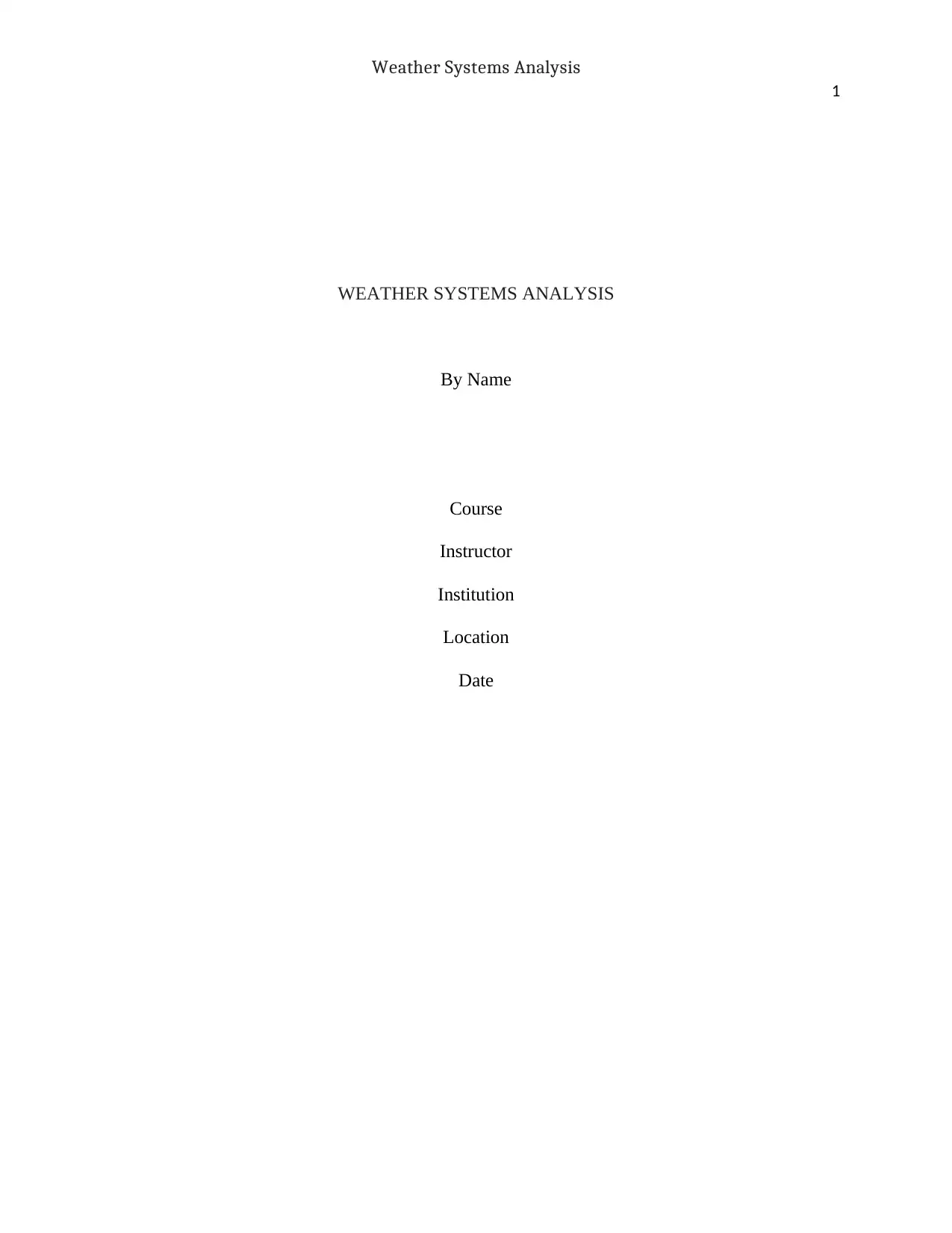
Weather Systems Analysis
1
WEATHER SYSTEMS ANALYSIS
By Name
Course
Instructor
Institution
Location
Date
1
WEATHER SYSTEMS ANALYSIS
By Name
Course
Instructor
Institution
Location
Date
Paraphrase This Document
Need a fresh take? Get an instant paraphrase of this document with our AI Paraphraser
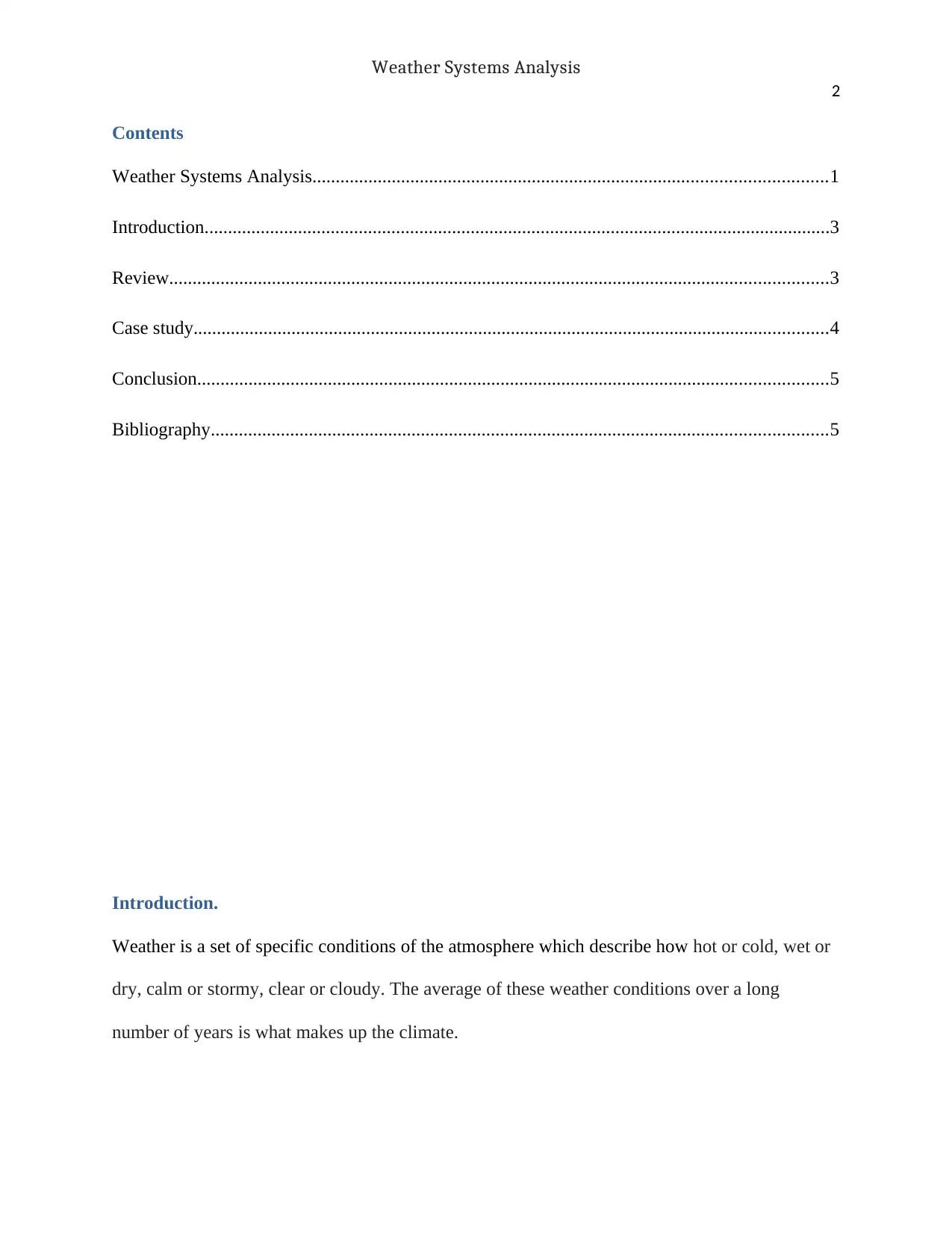
Weather Systems Analysis
2
Contents
Weather Systems Analysis..............................................................................................................1
Introduction......................................................................................................................................3
Review.............................................................................................................................................3
Case study........................................................................................................................................4
Conclusion.......................................................................................................................................5
Bibliography....................................................................................................................................5
Introduction.
Weather is a set of specific conditions of the atmosphere which describe how hot or cold, wet or
dry, calm or stormy, clear or cloudy. The average of these weather conditions over a long
number of years is what makes up the climate.
2
Contents
Weather Systems Analysis..............................................................................................................1
Introduction......................................................................................................................................3
Review.............................................................................................................................................3
Case study........................................................................................................................................4
Conclusion.......................................................................................................................................5
Bibliography....................................................................................................................................5
Introduction.
Weather is a set of specific conditions of the atmosphere which describe how hot or cold, wet or
dry, calm or stormy, clear or cloudy. The average of these weather conditions over a long
number of years is what makes up the climate.
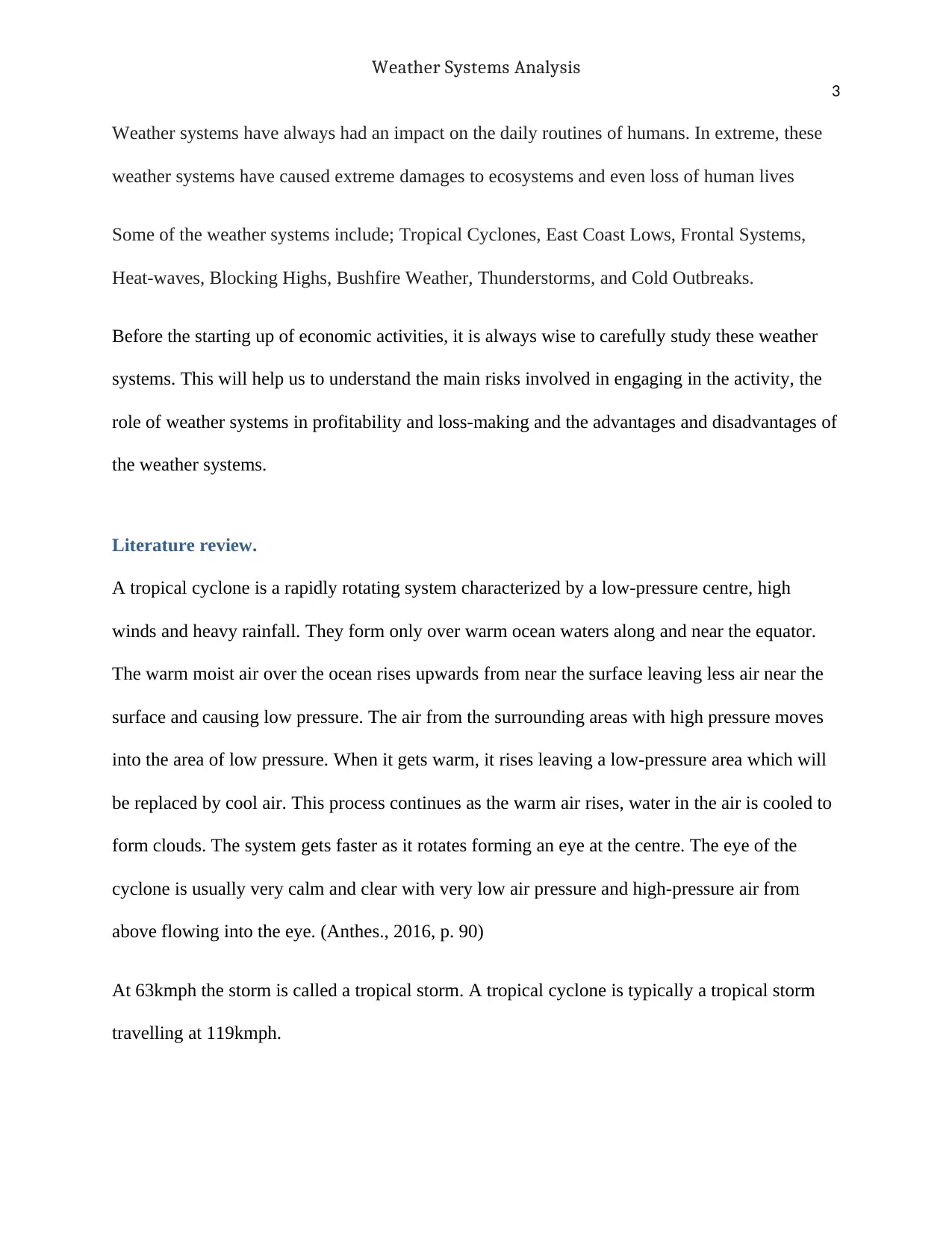
Weather Systems Analysis
3
Weather systems have always had an impact on the daily routines of humans. In extreme, these
weather systems have caused extreme damages to ecosystems and even loss of human lives
Some of the weather systems include; Tropical Cyclones, East Coast Lows, Frontal Systems,
Heat-waves, Blocking Highs, Bushfire Weather, Thunderstorms, and Cold Outbreaks.
Before the starting up of economic activities, it is always wise to carefully study these weather
systems. This will help us to understand the main risks involved in engaging in the activity, the
role of weather systems in profitability and loss-making and the advantages and disadvantages of
the weather systems.
Literature review.
A tropical cyclone is a rapidly rotating system characterized by a low-pressure centre, high
winds and heavy rainfall. They form only over warm ocean waters along and near the equator.
The warm moist air over the ocean rises upwards from near the surface leaving less air near the
surface and causing low pressure. The air from the surrounding areas with high pressure moves
into the area of low pressure. When it gets warm, it rises leaving a low-pressure area which will
be replaced by cool air. This process continues as the warm air rises, water in the air is cooled to
form clouds. The system gets faster as it rotates forming an eye at the centre. The eye of the
cyclone is usually very calm and clear with very low air pressure and high-pressure air from
above flowing into the eye. (Anthes., 2016, p. 90)
At 63kmph the storm is called a tropical storm. A tropical cyclone is typically a tropical storm
travelling at 119kmph.
3
Weather systems have always had an impact on the daily routines of humans. In extreme, these
weather systems have caused extreme damages to ecosystems and even loss of human lives
Some of the weather systems include; Tropical Cyclones, East Coast Lows, Frontal Systems,
Heat-waves, Blocking Highs, Bushfire Weather, Thunderstorms, and Cold Outbreaks.
Before the starting up of economic activities, it is always wise to carefully study these weather
systems. This will help us to understand the main risks involved in engaging in the activity, the
role of weather systems in profitability and loss-making and the advantages and disadvantages of
the weather systems.
Literature review.
A tropical cyclone is a rapidly rotating system characterized by a low-pressure centre, high
winds and heavy rainfall. They form only over warm ocean waters along and near the equator.
The warm moist air over the ocean rises upwards from near the surface leaving less air near the
surface and causing low pressure. The air from the surrounding areas with high pressure moves
into the area of low pressure. When it gets warm, it rises leaving a low-pressure area which will
be replaced by cool air. This process continues as the warm air rises, water in the air is cooled to
form clouds. The system gets faster as it rotates forming an eye at the centre. The eye of the
cyclone is usually very calm and clear with very low air pressure and high-pressure air from
above flowing into the eye. (Anthes., 2016, p. 90)
At 63kmph the storm is called a tropical storm. A tropical cyclone is typically a tropical storm
travelling at 119kmph.
⊘ This is a preview!⊘
Do you want full access?
Subscribe today to unlock all pages.

Trusted by 1+ million students worldwide
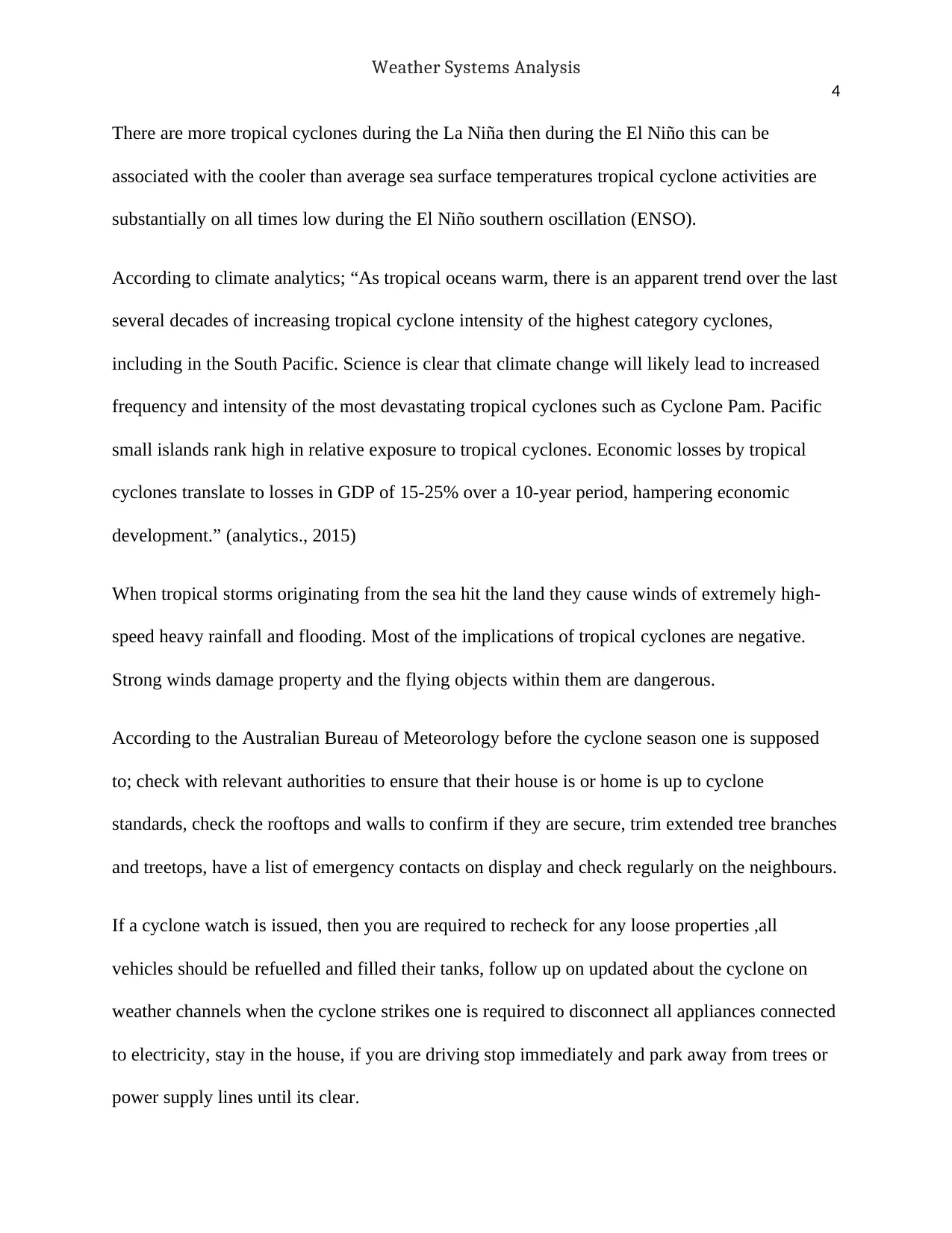
Weather Systems Analysis
4
There are more tropical cyclones during the La Niña then during the El Niño this can be
associated with the cooler than average sea surface temperatures tropical cyclone activities are
substantially on all times low during the El Niño southern oscillation (ENSO).
According to climate analytics; “As tropical oceans warm, there is an apparent trend over the last
several decades of increasing tropical cyclone intensity of the highest category cyclones,
including in the South Pacific. Science is clear that climate change will likely lead to increased
frequency and intensity of the most devastating tropical cyclones such as Cyclone Pam. Pacific
small islands rank high in relative exposure to tropical cyclones. Economic losses by tropical
cyclones translate to losses in GDP of 15-25% over a 10-year period, hampering economic
development.” (analytics., 2015)
When tropical storms originating from the sea hit the land they cause winds of extremely high-
speed heavy rainfall and flooding. Most of the implications of tropical cyclones are negative.
Strong winds damage property and the flying objects within them are dangerous.
According to the Australian Bureau of Meteorology before the cyclone season one is supposed
to; check with relevant authorities to ensure that their house is or home is up to cyclone
standards, check the rooftops and walls to confirm if they are secure, trim extended tree branches
and treetops, have a list of emergency contacts on display and check regularly on the neighbours.
If a cyclone watch is issued, then you are required to recheck for any loose properties ,all
vehicles should be refuelled and filled their tanks, follow up on updated about the cyclone on
weather channels when the cyclone strikes one is required to disconnect all appliances connected
to electricity, stay in the house, if you are driving stop immediately and park away from trees or
power supply lines until its clear.
4
There are more tropical cyclones during the La Niña then during the El Niño this can be
associated with the cooler than average sea surface temperatures tropical cyclone activities are
substantially on all times low during the El Niño southern oscillation (ENSO).
According to climate analytics; “As tropical oceans warm, there is an apparent trend over the last
several decades of increasing tropical cyclone intensity of the highest category cyclones,
including in the South Pacific. Science is clear that climate change will likely lead to increased
frequency and intensity of the most devastating tropical cyclones such as Cyclone Pam. Pacific
small islands rank high in relative exposure to tropical cyclones. Economic losses by tropical
cyclones translate to losses in GDP of 15-25% over a 10-year period, hampering economic
development.” (analytics., 2015)
When tropical storms originating from the sea hit the land they cause winds of extremely high-
speed heavy rainfall and flooding. Most of the implications of tropical cyclones are negative.
Strong winds damage property and the flying objects within them are dangerous.
According to the Australian Bureau of Meteorology before the cyclone season one is supposed
to; check with relevant authorities to ensure that their house is or home is up to cyclone
standards, check the rooftops and walls to confirm if they are secure, trim extended tree branches
and treetops, have a list of emergency contacts on display and check regularly on the neighbours.
If a cyclone watch is issued, then you are required to recheck for any loose properties ,all
vehicles should be refuelled and filled their tanks, follow up on updated about the cyclone on
weather channels when the cyclone strikes one is required to disconnect all appliances connected
to electricity, stay in the house, if you are driving stop immediately and park away from trees or
power supply lines until its clear.
Paraphrase This Document
Need a fresh take? Get an instant paraphrase of this document with our AI Paraphraser
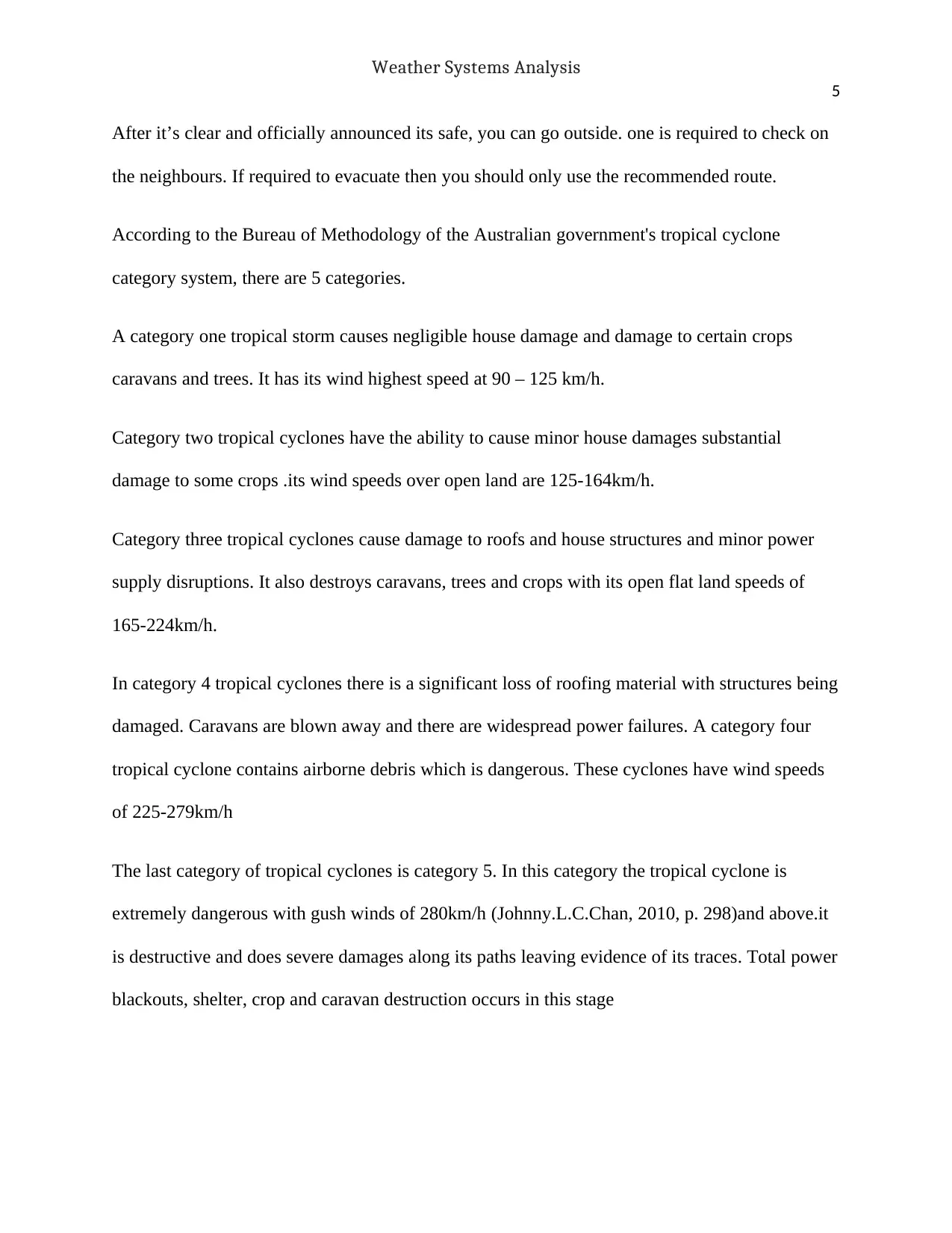
Weather Systems Analysis
5
After it’s clear and officially announced its safe, you can go outside. one is required to check on
the neighbours. If required to evacuate then you should only use the recommended route.
According to the Bureau of Methodology of the Australian government's tropical cyclone
category system, there are 5 categories.
A category one tropical storm causes negligible house damage and damage to certain crops
caravans and trees. It has its wind highest speed at 90 – 125 km/h.
Category two tropical cyclones have the ability to cause minor house damages substantial
damage to some crops .its wind speeds over open land are 125-164km/h.
Category three tropical cyclones cause damage to roofs and house structures and minor power
supply disruptions. It also destroys caravans, trees and crops with its open flat land speeds of
165-224km/h.
In category 4 tropical cyclones there is a significant loss of roofing material with structures being
damaged. Caravans are blown away and there are widespread power failures. A category four
tropical cyclone contains airborne debris which is dangerous. These cyclones have wind speeds
of 225-279km/h
The last category of tropical cyclones is category 5. In this category the tropical cyclone is
extremely dangerous with gush winds of 280km/h (Johnny.L.C.Chan, 2010, p. 298)and above.it
is destructive and does severe damages along its paths leaving evidence of its traces. Total power
blackouts, shelter, crop and caravan destruction occurs in this stage
5
After it’s clear and officially announced its safe, you can go outside. one is required to check on
the neighbours. If required to evacuate then you should only use the recommended route.
According to the Bureau of Methodology of the Australian government's tropical cyclone
category system, there are 5 categories.
A category one tropical storm causes negligible house damage and damage to certain crops
caravans and trees. It has its wind highest speed at 90 – 125 km/h.
Category two tropical cyclones have the ability to cause minor house damages substantial
damage to some crops .its wind speeds over open land are 125-164km/h.
Category three tropical cyclones cause damage to roofs and house structures and minor power
supply disruptions. It also destroys caravans, trees and crops with its open flat land speeds of
165-224km/h.
In category 4 tropical cyclones there is a significant loss of roofing material with structures being
damaged. Caravans are blown away and there are widespread power failures. A category four
tropical cyclone contains airborne debris which is dangerous. These cyclones have wind speeds
of 225-279km/h
The last category of tropical cyclones is category 5. In this category the tropical cyclone is
extremely dangerous with gush winds of 280km/h (Johnny.L.C.Chan, 2010, p. 298)and above.it
is destructive and does severe damages along its paths leaving evidence of its traces. Total power
blackouts, shelter, crop and caravan destruction occurs in this stage
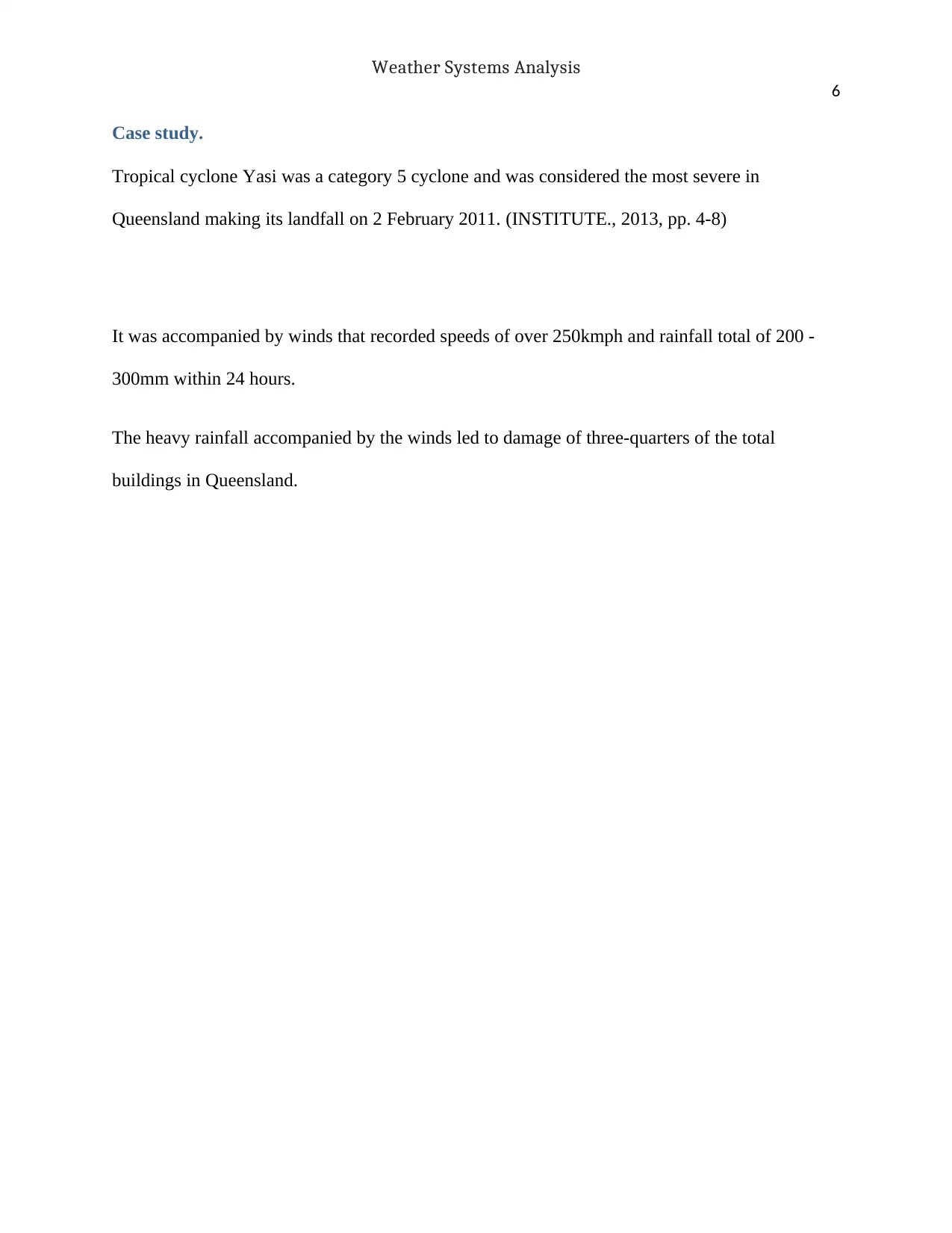
Weather Systems Analysis
6
Case study.
Tropical cyclone Yasi was a category 5 cyclone and was considered the most severe in
Queensland making its landfall on 2 February 2011. (INSTITUTE., 2013, pp. 4-8)
It was accompanied by winds that recorded speeds of over 250kmph and rainfall total of 200 -
300mm within 24 hours.
The heavy rainfall accompanied by the winds led to damage of three-quarters of the total
buildings in Queensland.
6
Case study.
Tropical cyclone Yasi was a category 5 cyclone and was considered the most severe in
Queensland making its landfall on 2 February 2011. (INSTITUTE., 2013, pp. 4-8)
It was accompanied by winds that recorded speeds of over 250kmph and rainfall total of 200 -
300mm within 24 hours.
The heavy rainfall accompanied by the winds led to damage of three-quarters of the total
buildings in Queensland.
⊘ This is a preview!⊘
Do you want full access?
Subscribe today to unlock all pages.

Trusted by 1+ million students worldwide
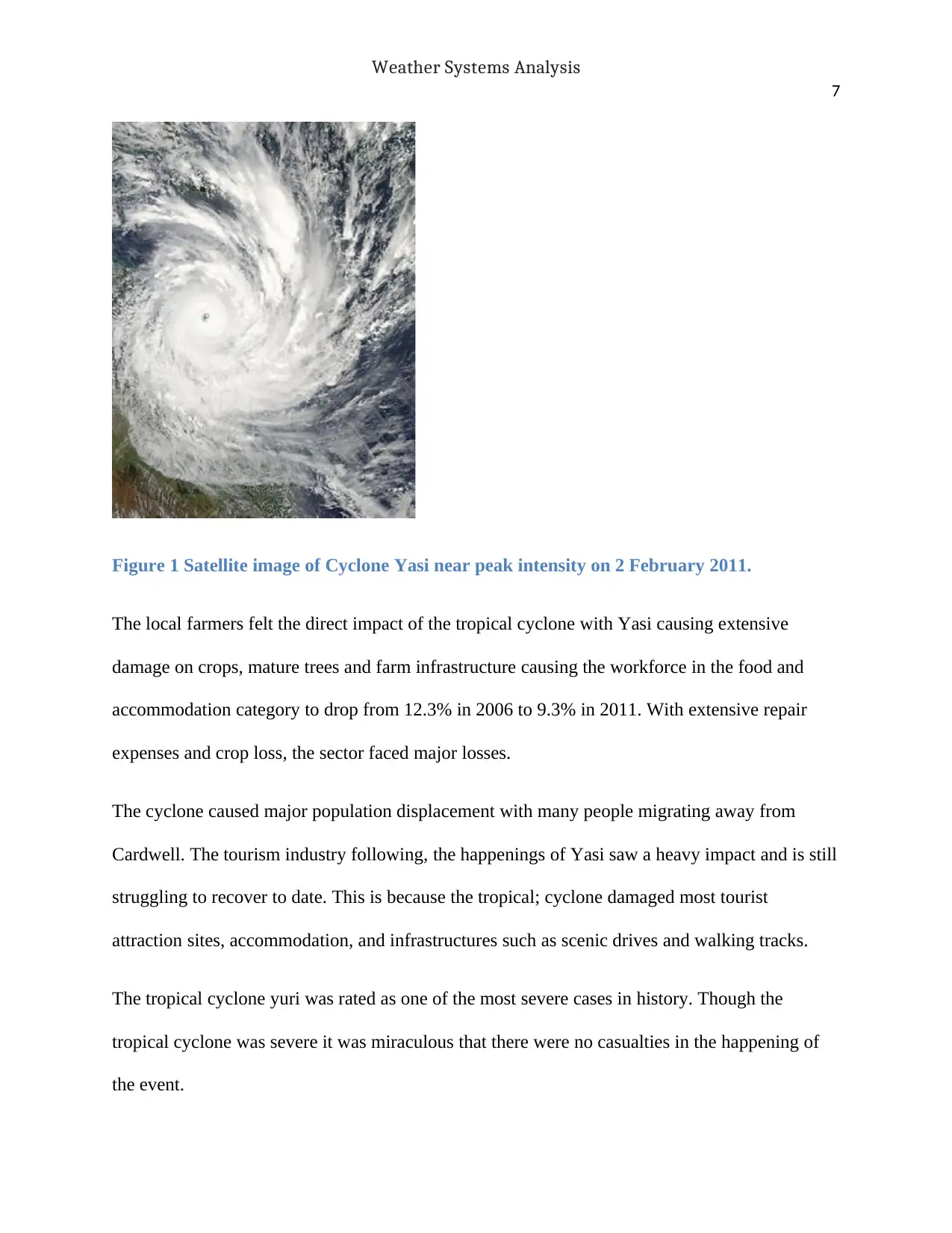
Weather Systems Analysis
7
Figure 1 Satellite image of Cyclone Yasi near peak intensity on 2 February 2011.
The local farmers felt the direct impact of the tropical cyclone with Yasi causing extensive
damage on crops, mature trees and farm infrastructure causing the workforce in the food and
accommodation category to drop from 12.3% in 2006 to 9.3% in 2011. With extensive repair
expenses and crop loss, the sector faced major losses.
The cyclone caused major population displacement with many people migrating away from
Cardwell. The tourism industry following, the happenings of Yasi saw a heavy impact and is still
struggling to recover to date. This is because the tropical; cyclone damaged most tourist
attraction sites, accommodation, and infrastructures such as scenic drives and walking tracks.
The tropical cyclone yuri was rated as one of the most severe cases in history. Though the
tropical cyclone was severe it was miraculous that there were no casualties in the happening of
the event.
7
Figure 1 Satellite image of Cyclone Yasi near peak intensity on 2 February 2011.
The local farmers felt the direct impact of the tropical cyclone with Yasi causing extensive
damage on crops, mature trees and farm infrastructure causing the workforce in the food and
accommodation category to drop from 12.3% in 2006 to 9.3% in 2011. With extensive repair
expenses and crop loss, the sector faced major losses.
The cyclone caused major population displacement with many people migrating away from
Cardwell. The tourism industry following, the happenings of Yasi saw a heavy impact and is still
struggling to recover to date. This is because the tropical; cyclone damaged most tourist
attraction sites, accommodation, and infrastructures such as scenic drives and walking tracks.
The tropical cyclone yuri was rated as one of the most severe cases in history. Though the
tropical cyclone was severe it was miraculous that there were no casualties in the happening of
the event.
Paraphrase This Document
Need a fresh take? Get an instant paraphrase of this document with our AI Paraphraser
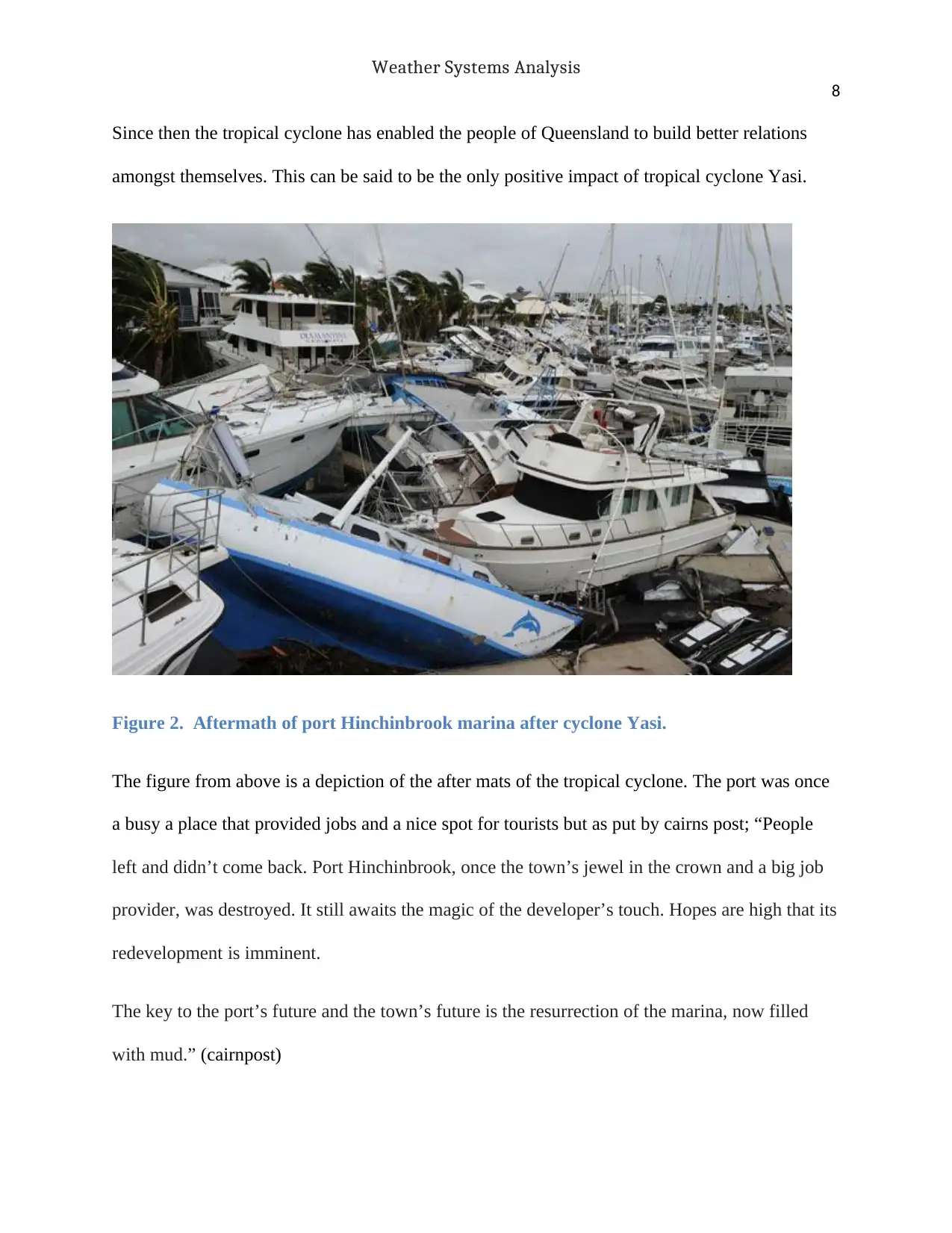
Weather Systems Analysis
8
Since then the tropical cyclone has enabled the people of Queensland to build better relations
amongst themselves. This can be said to be the only positive impact of tropical cyclone Yasi.
Figure 2. Aftermath of port Hinchinbrook marina after cyclone Yasi.
The figure from above is a depiction of the after mats of the tropical cyclone. The port was once
a busy a place that provided jobs and a nice spot for tourists but as put by cairns post; “People
left and didn’t come back. Port Hinchinbrook, once the town’s jewel in the crown and a big job
provider, was destroyed. It still awaits the magic of the developer’s touch. Hopes are high that its
redevelopment is imminent.
The key to the port’s future and the town’s future is the resurrection of the marina, now filled
with mud.” (cairnpost)
8
Since then the tropical cyclone has enabled the people of Queensland to build better relations
amongst themselves. This can be said to be the only positive impact of tropical cyclone Yasi.
Figure 2. Aftermath of port Hinchinbrook marina after cyclone Yasi.
The figure from above is a depiction of the after mats of the tropical cyclone. The port was once
a busy a place that provided jobs and a nice spot for tourists but as put by cairns post; “People
left and didn’t come back. Port Hinchinbrook, once the town’s jewel in the crown and a big job
provider, was destroyed. It still awaits the magic of the developer’s touch. Hopes are high that its
redevelopment is imminent.
The key to the port’s future and the town’s future is the resurrection of the marina, now filled
with mud.” (cairnpost)
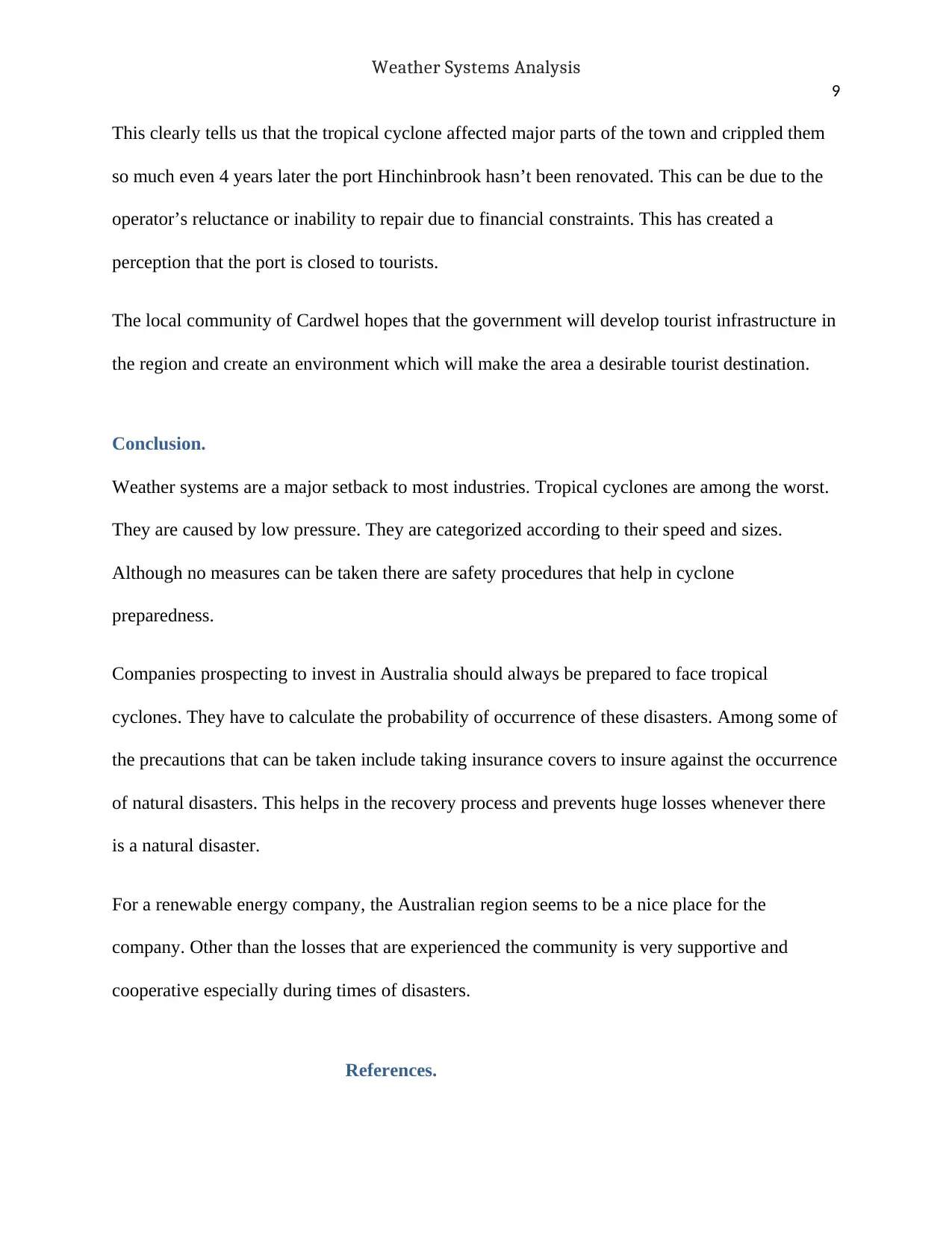
Weather Systems Analysis
9
This clearly tells us that the tropical cyclone affected major parts of the town and crippled them
so much even 4 years later the port Hinchinbrook hasn’t been renovated. This can be due to the
operator’s reluctance or inability to repair due to financial constraints. This has created a
perception that the port is closed to tourists.
The local community of Cardwel hopes that the government will develop tourist infrastructure in
the region and create an environment which will make the area a desirable tourist destination.
Conclusion.
Weather systems are a major setback to most industries. Tropical cyclones are among the worst.
They are caused by low pressure. They are categorized according to their speed and sizes.
Although no measures can be taken there are safety procedures that help in cyclone
preparedness.
Companies prospecting to invest in Australia should always be prepared to face tropical
cyclones. They have to calculate the probability of occurrence of these disasters. Among some of
the precautions that can be taken include taking insurance covers to insure against the occurrence
of natural disasters. This helps in the recovery process and prevents huge losses whenever there
is a natural disaster.
For a renewable energy company, the Australian region seems to be a nice place for the
company. Other than the losses that are experienced the community is very supportive and
cooperative especially during times of disasters.
References.
9
This clearly tells us that the tropical cyclone affected major parts of the town and crippled them
so much even 4 years later the port Hinchinbrook hasn’t been renovated. This can be due to the
operator’s reluctance or inability to repair due to financial constraints. This has created a
perception that the port is closed to tourists.
The local community of Cardwel hopes that the government will develop tourist infrastructure in
the region and create an environment which will make the area a desirable tourist destination.
Conclusion.
Weather systems are a major setback to most industries. Tropical cyclones are among the worst.
They are caused by low pressure. They are categorized according to their speed and sizes.
Although no measures can be taken there are safety procedures that help in cyclone
preparedness.
Companies prospecting to invest in Australia should always be prepared to face tropical
cyclones. They have to calculate the probability of occurrence of these disasters. Among some of
the precautions that can be taken include taking insurance covers to insure against the occurrence
of natural disasters. This helps in the recovery process and prevents huge losses whenever there
is a natural disaster.
For a renewable energy company, the Australian region seems to be a nice place for the
company. Other than the losses that are experienced the community is very supportive and
cooperative especially during times of disasters.
References.
⊘ This is a preview!⊘
Do you want full access?
Subscribe today to unlock all pages.

Trusted by 1+ million students worldwide
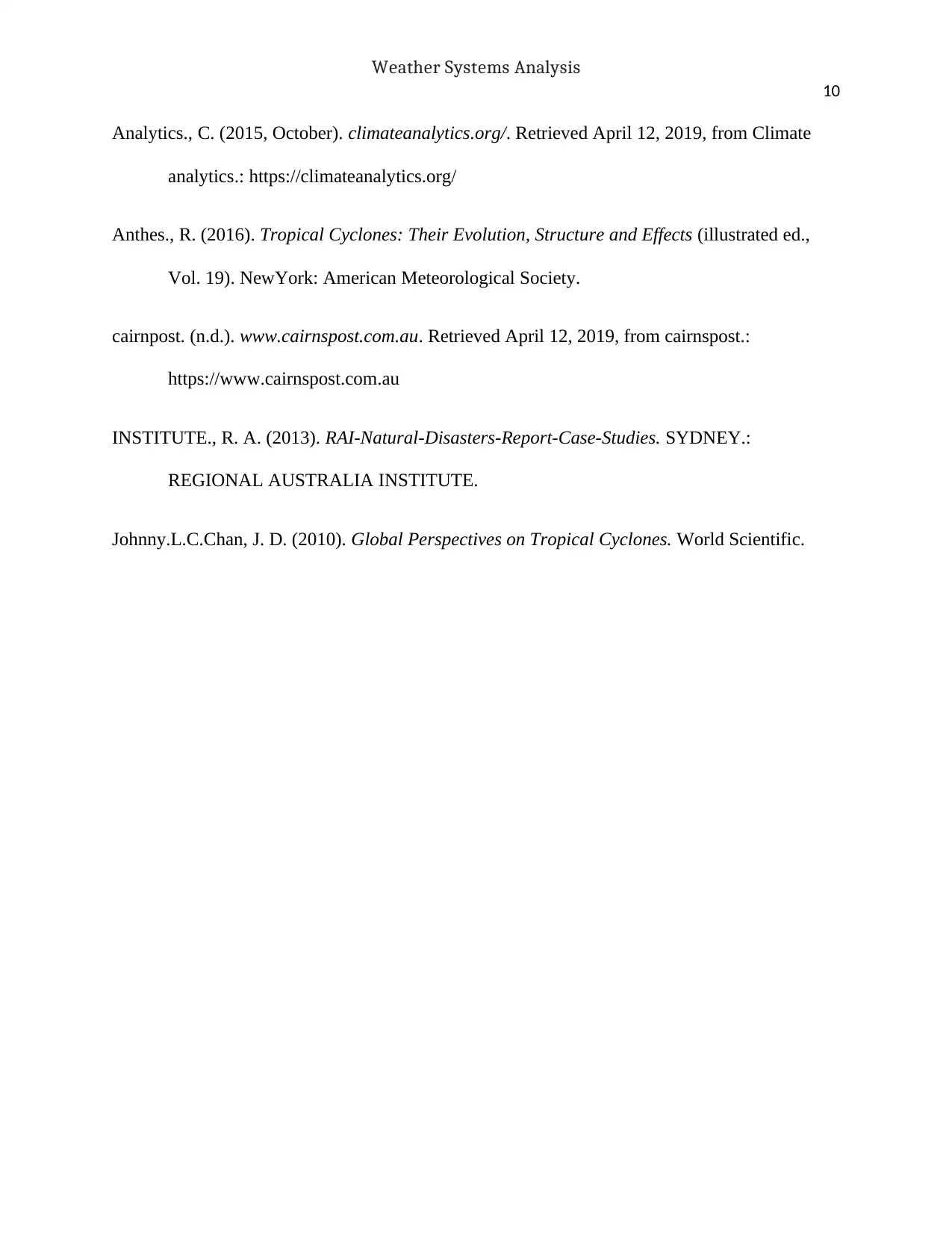
Weather Systems Analysis
10
Analytics., C. (2015, October). climateanalytics.org/. Retrieved April 12, 2019, from Climate
analytics.: https://climateanalytics.org/
Anthes., R. (2016). Tropical Cyclones: Their Evolution, Structure and Effects (illustrated ed.,
Vol. 19). NewYork: American Meteorological Society.
cairnpost. (n.d.). www.cairnspost.com.au. Retrieved April 12, 2019, from cairnspost.:
https://www.cairnspost.com.au
INSTITUTE., R. A. (2013). RAI-Natural-Disasters-Report-Case-Studies. SYDNEY.:
REGIONAL AUSTRALIA INSTITUTE.
Johnny.L.C.Chan, J. D. (2010). Global Perspectives on Tropical Cyclones. World Scientific.
10
Analytics., C. (2015, October). climateanalytics.org/. Retrieved April 12, 2019, from Climate
analytics.: https://climateanalytics.org/
Anthes., R. (2016). Tropical Cyclones: Their Evolution, Structure and Effects (illustrated ed.,
Vol. 19). NewYork: American Meteorological Society.
cairnpost. (n.d.). www.cairnspost.com.au. Retrieved April 12, 2019, from cairnspost.:
https://www.cairnspost.com.au
INSTITUTE., R. A. (2013). RAI-Natural-Disasters-Report-Case-Studies. SYDNEY.:
REGIONAL AUSTRALIA INSTITUTE.
Johnny.L.C.Chan, J. D. (2010). Global Perspectives on Tropical Cyclones. World Scientific.
1 out of 10
Related Documents
Your All-in-One AI-Powered Toolkit for Academic Success.
+13062052269
info@desklib.com
Available 24*7 on WhatsApp / Email
![[object Object]](/_next/static/media/star-bottom.7253800d.svg)
Unlock your academic potential
Copyright © 2020–2025 A2Z Services. All Rights Reserved. Developed and managed by ZUCOL.





